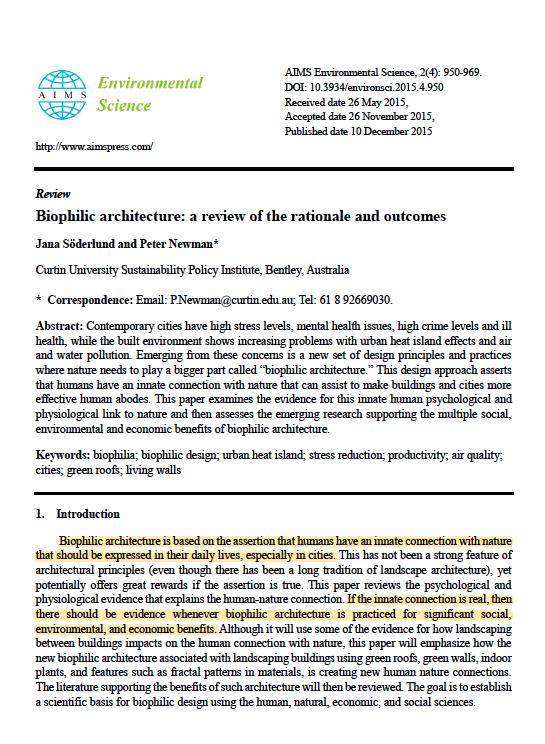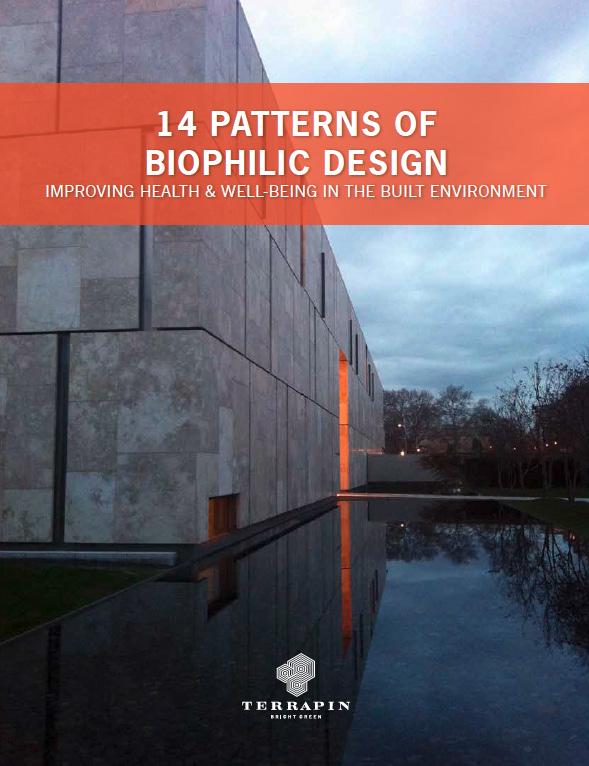
4 minute read
Literature Review
History Matters: The Origins of Biophilic Design of Innovative Learning Spaces in Traditional Architecture
Author: Mohammed Abdelaal & Veronica Soebarto
Advertisement
Abdelaal argues in this article that there is a need for biophilic design in educational spaces. He also states that there have been many multidisciplinary studies that outline the benefits of biophilia to academic performance. The article outlines a few case studies of innovative biophilic education spaces.
Biophilic architecture: a review of the rationale and outcomes
Author: Jana Söderlund, & Peter Newman

The article explores the rationale of designing biophilically. Soderlund explores the economic and mental health benefits of designing with the 14 principles of biophilia. The conclusion is that there is a significant benefit to designing biophilically both from a wellness and ecological perspective.
14 Patterns of Biophilic Design: Improving Health and Wellbeing in the Built Environment
Author: William Browning

This book outlines the 14 principles of biophilia that will be used in this thesis. The book goes details the rationale of designing with biophilia and the reasons behind the 14 principles of biophilia.
Biophilia and Salutogensis as a restorative design approaches in healthcare architecture
Author: Mohammed Abdelaal & Veronica Soebarto

This article explores the benefits to designing with biophilia in the healthcare context and uses three cases studies, namely the Royal Children’s Hospital in Melbourne to argue their point. They conclude that the built environment does play a role in the health and wellbeing of people, but also that there is minimal literature and studies on the subject.
Lo-TEK Design by Radial Indigenism
Author: Julia Watson

Watson explores the idea that indigenous wisdom has been lost in recent times. She argues that the architectural and buildings techniques (inspired by nature) were much more well evolved, ecologically sensitive and culturally sensitive than modern architecture. She concluded that there is a lot to be gained by looking to our past to inform our future architecture.
Authenticity, Sincerity and Spontaneity: The Mutual Implication of Nature and Religion in China and the West
Author: James Miller
This article outlines the role that nature had in the religious symbology (architecture and ornament) for western and eastern cultures historically.
Cognitive and Evolutionary Speculations for Biomorphic Architecture
Author: Yannich Joye

This article outlines the role that environments had on shaping our evolutionary needs as humans. Joye outlines different landscape elements such as trees and flowers give us cues and have shaped our modern desires. The article also explores the role of biomorphic architecture has in helping to cater to our primitive desires.
Incorporating biophilia into green building rating tools for promoting health and wellbeing
Author: Fei Xue

This article explores the role of green rating tools such as the Green Star Rating System and the WELL Standard in creating buildings that are health and promote wellbeing. Xue points out that Green Building rating tools, while effective in lowering the ecological impact of buildings they do not take into consideration wellbeing in architecture. Xue argues that biophilia ideals need to be incorporated into the green building tools for them to be holistically sustainable.
OC21: Our Campus in the 21st Century
Author: The University of Melbourne

The report developed by the University of Melbourne outlines the goals and ideals of the university for the future.
The Hidden Ways that Architecture Affects how you Feel
Author: Michael Bond

This article outlines that way the buildings and cities are designed can affect our mood and wellbeing. It outlines scientific breakthroughs in understanding exactly how architecture influences our brain from a neuroscience perspective. The article also discusses the unmet need of architects and psychologists are working together to start to better understand how our environment affects us.
Classrooms with Nature Views: Evidence of Differing Perceptions and Behaviors
Author: Joshua Benfield

Benfield outlined in this article that natural environments have been shown to restore cognitive abilities and reduce physiological arousal. This journal outlines a study that was undertaken to get data on the benefits of having access to nature in a educational setting. It was concluded that natural views offer advantages and suggest that the inclusion of natural elements in courses could facilitate positive perceptions and better grades.
Biophilia as the Main Design Question in Architectural Design Studio Teaching
Author: Kutlu Sevinc Kayihan

This article outlines a study that was performed to see how architectural students would perform when they were given a biophilic brief. It corroborated some of the other journals that have been discussed in this literature review in regards to the benefits of biophilia in education settings. The student outcomes focused around using natural materials and light to achieve their desired result of a biophilic building.








